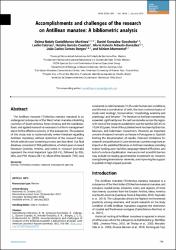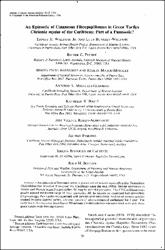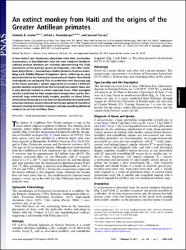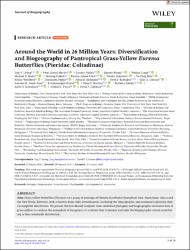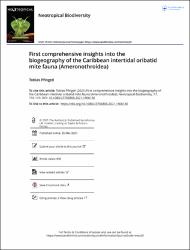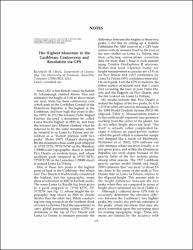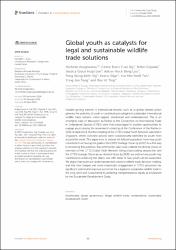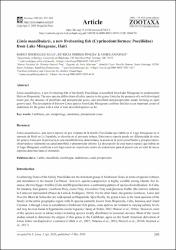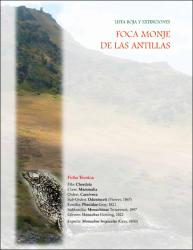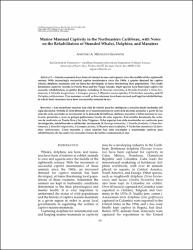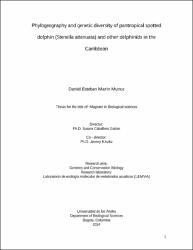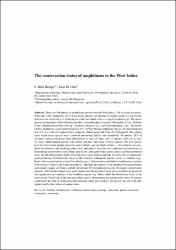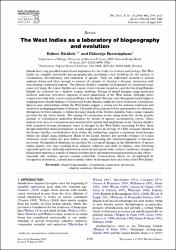Browsing Investigación ambiental by Subject "Fauna"
Now showing items 1-18 of 18
-
Accomplishments and challenges of the research on Antillean manatee : A bibliometric analysis
(2023)The Antillean manatee (Trichechus manatus manatus) is an endangered subspecies of the West Indian manatee inhabiting countries of South America, Meso America and the Caribbean. Basic and applied research is necessary to ... -
An epizootic of cutaneous fibropapillomas in green turtles Chelonia mydas of the Caribbean : part of a panzootic?
(1994)An epizootic of fibropapillomas in green turtles Chelonia mydas (Reptilia: Testudines: Cheloniidae) has occurred throughout the Caribbean since the mid-1980s. Similar epizootics in Hawaii and Florida began 5 years earlier. ... -
An extinct monkey from Haiti and the origins of the Greater Antillean primates
(2011)A new extinct Late Quaternary platyrrhine from Haiti, Insulacebus toussaintiana, is described here from the most complete Caribbean subfossil primate dentition yet recorded, demonstrating the likely coexistence of two ... -
Around the world in 26 million years : diversification and biogeography of pantropical Grass-yellow Eurema butterflies (Pieridae: Coliadinae)
(2025)Aim: Grass-yellow butterflies (Eurema) are a group of pantropical Pieridae distributed throughout Asia, Australasia, Africa and the New World. However, little is known about their diversification, including the biogeographic ... -
Causes of endemic radiation in the Caribbean: evidence from the historical biogeography and diversification of the butterfly genus Calisto (Nymphalidae: Satyrinae: Satyrini)
(2014)Calisto is the largest butterfly genus in the West Indies but its systematics, historical biogeography and the causes of its diversification have not been previously rigorously evaluated. Several studies attempting to ... -
Determination of gender in cetaceans by the polymerase chain reaction
(1992)We determined the gender of a variety of cet can species, including both ondotocetes and mysticetes, using the polymerase chain reaction for amplification of the sex chromosome specific regions ZFY/ZFX and SRY. This quick ... -
Echinoderm diversity in the Caribbean Sea
(2011)The Caribbean is considered a unique biogeographic province, being one of the top five hotspots in the world for marine and terrestrial biodiversity. The echinoderm research on the Caribbean began in the middle of the ... -
Evolutionary rate shifts in coding and regulatory regions underpin repeated adaptation to sulfidic streams in poeciliid fishes
(2024)Adaptation to extreme environments often involves the evolution of dramatic physiological changes. To better understand how organisms evolve these complex phenotypic changes, the repeatability and predictability of evolution, ... -
First comprehensive insights into the biogeography of the Caribbean intertidal oribatid mite fauna (Ameronothroidea)
(2021)A decade ago the Caribbean was almost completely uncharted in terms of intertidal ameronothroid mites. Now the present data show that these organisms are a common component of the fauna of Caribbean shorelines. Two families ... -
First records of the pantropical spotted dolphin (Stenella attenuata) for the Puerto Rican Bank, with a review of the species in the Caribbean
(2003)Pantropical spotted dolphins are the most abundant cetaceans in the northern Gulf of Mexico, with a population estimate of 91,321, but are less common in the eastern U.S. Atlantic, where estimates are 12,747. No current ... -
Global youth as catalysts for legal and sustainable wildlife trade solutions
(2025)Despite gaining traction in international forums, such as in global climate action spheres, the potential of youth in contributing to a legal and sustainable international wildlife trade remains under-tapped, overlooked ... -
Limia mandibularis, a new livebearing fish (Cyprinodontiformes: Poeciliidae) from Lake Miragoane, Haiti
(2020)Limia mandibularis, a new livebearing fish of the family Poeciliidae is described from Lake Miragoane in southwestern Haiti on Hispaniola. The new species differs from all other species in the genus Limia by the presence ... -
Lista Roja y extinciones : la foca monje
(2011)La foca monje del Caribe fue formalmente declarada extinta en 1996, en la Lista Roja de Animales Amenazados de la UICN. La última vez que se vio fue en 1952, en el Banco Seranilla, entre Jamaica y Honduras, donde se sabía ... -
Marine mammal captivity in the northeastern Caribbean, with notes on the rehabilitation of stranded whales, dolphins and manatees
(1998)ABSTRACT. —Marine mammals have been of interest to zoos and aquaria since the middle of the eighteenth century. With increasingly successful captive maintenance since the 1960s, a greater demand for captive whales, dolphins, ... -
Phylogeography and genetic diversity of pantropical spotted dolphin (Stenella attenuata) and other delphinids in the Caribbean
(2024)The pantropical spotted dolphin (Stenella attenuata) is a cetacean species with a broad distribution encompassing tropical waters. However, this species can exhibit geographic variations in coloration and morphology. Such ... -
Rapid size change associated with intra-island evolutionary radiation in extinct Caribbean “island-shrews”
(2020)The Caribbean offers a unique opportunity to study evolutionary dynamics in insular mammals. However, the recent extinction of most Caribbean non-volant mammals has obstructed evolutionary studies, and poor DNA preservation ... -
The conservation status of amphibians in the West Indies
(2011)There are 196 species of amphibians known from the West Indies, 188 of which are native. With only a few exceptions, all of those native species are endemic to single islands or island banks, and most are restricted to a ... -
The West Indies as a laboratory of biogeography and evolution
(2007)Islands have long provided material and inspiration for the study of evolution and ecology. The West Indies are complex historically and geographically, providing a rich backdrop for the analysis of colonization, diversification ...

